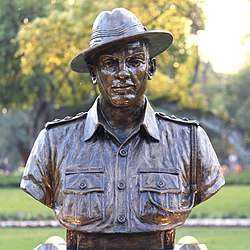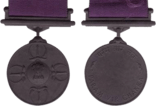Manoj Kumar Pandey
Manoj Kumar Pandey, PVC (25 June 1975 – 3 July 1999) was an officer of the Indian Army who was posthumously awarded India's highest military honour, the Param Vir Chakra, for his audacious courage and leadership during the Kargil War in 1999. An officer of the 1st battalion, 11 Gorkha Rifles (1/11 GR), he was Killed in action during the attack on Jubar Top of the Khalubar Hills in Batalik Sector of Kargil.
Manoj Kumar Pandey | |
|---|---|
 | |
| Born | 25 June 1975 Sitapur, Uttar Pradesh, India |
| Died | 3 July 1999 (aged 24) Bunker Ridge, Khalubar, Batalik Sector, Kargil, Ladakh, India |
| Allegiance | |
| Service/ | |
| Rank | |
| Unit | 1/11 Gorkha Rifles |
| Battles/wars | Kargil War Operation Vijay Battle of Kukarthan Battle of Khalubar |
| Awards | |
Early life
Pandey was born on 25 June 1975 in Rudha village, in the Sitapur district of Uttar Pradesh. He was born to Gopi Chand Pandey, a small-time businessman living in Lucknow, and Mohini. He was eldest in his family. He was educated at Uttar Pradesh Sainik School, Lucknow and Rani Laxmi Bai Memorial Senior Secondary School. He had a keen interest in sports with boxing and body building in particular. He was adjudged the best cadet of junior division NCC of Uttar Pradesh directorate in 1990.[1]
Prior to his selection, during his Services Selection Board (SSB) interview, the interviewer asked him, "Why do you want to join the Army?" He immediately replied, "I want to win the Param Vir Chakra." True to his words, Lieutenant Manoj Kumar Pandey did win the country's highest gallantry honour but posthumously.[2]
Military Career
He graduated from the National Defence Academy in 90th course and belonged to Mike Squadron (Mustangs).[4] Pandey was commissioned into the 1st battalion, 11 Gorkha Rifles in June 1997.[5]
Kargil War
In early May, the intrusion in the Kargil sector was reported.[6] The 1/11 Gorkha Rifles battalion had finished a one-and-a-half year tenure in the Siachen Glacier and was on-the-move to its peace-time location in Pune. The battalion was asked to move to the Batalik sector in Kargil. It was among the first units to be inducted into this sector. The unit, commanded by Colonel Lalit Rai, was assigned responsibility of the Jubar, Kukarthaam and Khalubar areas and their battalion headquarters was in Yeldor.[7]
Pandey, as part of the battalion, was involved in a series of boldly led attacks. He also took part in a series of actions which led to the capture of Jubar Top.[8]
Param Vir Chakra action
In early July, 'B' Company of 1/11 GR was assigned the task to capture Khalubar top. Pandey was commanding a Platoon in this company.[10] Quickly sizing up the situation, the young officer led his platoon along a narrow, treacherous ridge that led to the enemy position. While still short of the objective, the enemy fired upon the Indian soldiers effectively stalling the Indian attack. Displaying great courage, he surged ahead of his troops and charged at the enemy with a full-throated battle cry through a hail of bullets.Fearlessly assaulting the first enemy position, he killed two enemy personnel and destroyed the second position by killing two more.
Although wounded in the shoulder and leg, he pressed on his solitary charge with grim determination, until he closed in on the first bunker. The two armies engaged in a ferocious, hand-to-hand combat. The troops charged at the enemy and fell upon them. Undaunted and without caring for his grievous injuries, he continued to lead the assault on the fourth position urging his men and destroyed the same with a grenade, even as he got a fatal burst on his forehead. He collapsed at the final bunker and succumbed to his injuries.[11][8]
Citation
The Param Vir Chakra citation reads as follows:[12][13]
CITATION
LIEUTENANT MANOJ KUMAR PANDEY
1/11 GORKHA RIFLESLieutenant Manoj Kumar Pandey, a young officer of the 1/11 Gorkha Rifles, took part in a series of boldly led attacks during Operation Vijay, forcing back the intruders with heavy losses in Batalik, including the capture of Jubar Top.
His finest hour was during the advance to Khalubar, when he was Number 5 Platoon Commander. On the night of 2/3 July 1999, as the platoon approached its final objective, it came under heavy and intense enemy fire from the surrounding heights. The officer was tasked to clear the interfering enemy positions, so as to prevent his battalion from getting daylighted, being in a vulnerable position. The officer quickly moved his platoon to an advantageous position under intense enemy fire and sent one section to clear the enemy positions from the right, while he himself proceeded to clear four other enemy positions on the left. Fearlessly assaulting the first enemy position, he killed two enemy personnel and proceeded to assault the second and destroyed it by killing two more enemy personnel. Lieutenant Manoj Kumar Pandey was injured on the shoulder and legs by enemy fire while clearing the third position. Undaunted and without caring for his grievous injury, he led the assault on the fourth position urging his men and destroyed the same with a grenade, even as he got a fatal Medium Machine Gun burst on his forehead. It is this singular daredevil act of the officer, which provided the critical firm base for the companies, which finally led to capture of Khalubar.
Lieutenant Manoj Kumar Pandey, thus showed most conspicuous bravery, indomitable courage, exemplary personal valour, outstanding leadership and devotion to duty of an exceptionally high order, in the face of the enemy and made the supreme sacrifice in the highest traditions of the Army.
Gallantry award ceremony
On the occasion of Independence Day 1999, a month after the war ended, the President of India approved the award of the Param Vir Chakra to Pandey and three others - Captain Vikram Batra, Rifleman Sanjay Kumar and Grenadier Yogendra Singh Yadav.[14] His father, Gopichand Pandey, received the award from the President of India K. R. Narayanan during the Republic Day Parade in New Delhi on 26 January 2000.[11]
Honours and legacy

Pandey is one of the 21 individuals who have been decorated with India's highest military honour. As a PVC awardee, his statue is at the Param Yodha Sthal at the National War Memorial. After his death, multiple places have been named after him including his almae matres.
* Rani Laxmi Bai Memorial Senior Secondary School
- The constructed an auditorium in his name, which was inaugurated by his parents.[15]
UP Sainik School
- Pandey's alma mater, the Uttar Pradesh Sainik School, Lucknow was renamed after its most illustrious alumnus. It is now called CAPTAIN MANOJ KUMAR PANDEY U.P. SAINIK SCHOOL, LUCKNOW.[16]
- An auditorium in the school was named after him. Its foundation stone was laid by General VK Singh in 2011.[17]
- The school conducts an inter-school football tournament annually - 'Late Capt. Manoj Kr. Pandey PVC Football Tournament Trophy'.[18]
- The main gate named after him.
National Defence Academy
- The National Defence Academy named the science block as the "Manoj Pandey Block".[19]
- His portrait hangs at the Mike squadron of the academy.[5]
Services Selection Board, Allahabad
- A hall is made in the name of Capt. Manoj at Services Selection Board Allahabad named as Manoj Pandey Block.
Roads and buildings
- The Army Welfare Housing Organisation (AWHO) designed and constructed an apartment complex for veterans in Ghaziabad district, Uttar Pradesh, and named it for Pandey as "Manoj Vihar".
- The army quarters near the Cardio Thoracic Center (CTC) hospital in Pune is named after Martyr Capt Manoj Pandey as "Capt. Manoj Pandey Enclave"
- A roundabout is also named after Martyr Capt.Manoj Pandey as "Lieutenant Manoj Pandey Chowk" in his home district Sitapur, Uttar Pradesh and center of Gomti Nagar, Lucknow, Uttar Pradesh, India.
- A gallery in the Kargil War Museum at Dras is named after him.[20]
In popular culture
He was portrayed by Bollywood actor Ajay Devgan in the J.P.Dutta's film LOC Kargil.[21]
Notes
- National Cadet Corp, Youth in Action. New Delhi: Directorate General National Cadet Corps. 2003. ISBN 8170622980.
- "rediff.com: The Republic Special, Tribute to Param Vir Chakra winner Captain Manoj Pandey". m.rediff.com.
- "Salute to our asli heroes". Hindustan Times. 15 August 2012.
- mike squadron (Mustangs)
- May 31, TNN. "'He died the most glorious death' | Pune News - Times of India". The Times of India.
- "The Tribune, Chandigarh, India - Opinions". www.tribuneindia.com.
- "20 years after Kargil: The Gorkha Rifles' Pune-to-Kargil about turn, a move for the nation". Hindustan Times. 26 July 2019.
- The Param Vir Chakra Winners (PVC), Official Website of the Indian Army, retrieved 28 August 2014 "Profile" and "Citation" tabs.
- "Indian Army Day 2020 Wishes, Images, Cards and Inspiration Quotes". The Quint. 15 January 2020.
- "Captain Manoj Kumar Pandey PVC | Honourpoint".
- Bellamy 2011.
- "MANOJ KUMAR PANDEY | Gallantry Awards". gallantryawards.gov.in.
- "Param Vir Chakra (PVC), Awardee: Lt Manoj Kumar Pandey , PVC @ TWDI". twdi.in.
- "INDEPENDENCE DAY GALLANTRY AWARDS FOR OPERATION VIJAY" (PDF). pibarchive.nic.in. 14 August 1999.
- "RLB CHINHAT". rlbcn.org.
- "CAPTAIN MANOJ KUMAR PANDEY U.P. SAINIK SCHOOL, LUCKNOW – We Prepare Best Army Men".
- "Infrastructure & Facilities | U.P. SAINIK SCHOOL". www.upsainikschool.org. Retrieved 27 July 2016.
- "Trophies | U.P. SAINIK SCHOOL". www.upsainikschool.org. Retrieved 27 July 2016.
- "National Defence Academy, NDA Pune | Places of Interest in and around NDA, Khadakvasala". Nda.nic.in. Archived from the original on 29 September 2011. Retrieved 17 October 2011.
- http://www.rediff.com/news/slide-show/slide-show-1-drass-memorial-invoking-memories-of-kargil-war/20110727.htm#4
- LOC: Kargil, retrieved 23 May 2020
References
- Bellamy, Chris (2011), The Gurkhas: Special Force, Hodder And Stoughton, ISBN 978-1848543423
External links
- Indian Army Webpage
- Manoj Pandey Chowk is at coordinates 26°51′14″N 80°59′40″E
